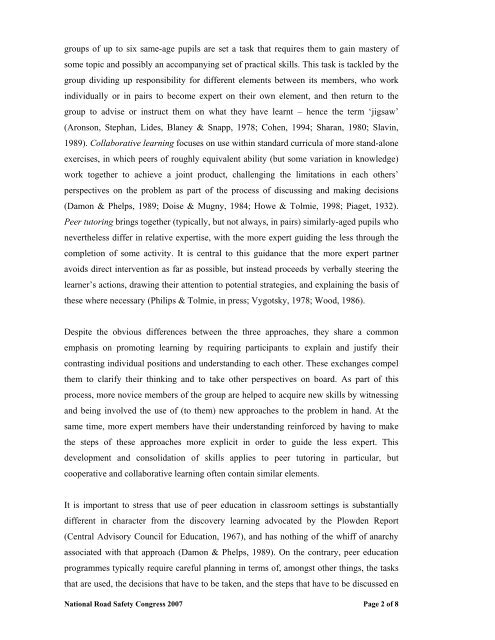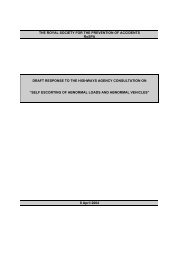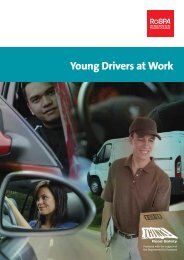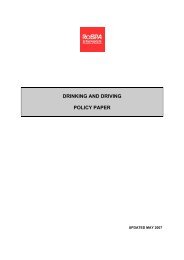Prof Andrew Tolmie, Professor of Psychology and Human ... - RoSPA
Prof Andrew Tolmie, Professor of Psychology and Human ... - RoSPA
Prof Andrew Tolmie, Professor of Psychology and Human ... - RoSPA
Create successful ePaper yourself
Turn your PDF publications into a flip-book with our unique Google optimized e-Paper software.
groups <strong>of</strong> up to six same-age pupils are set a task that requires them to gain mastery <strong>of</strong><br />
some topic <strong>and</strong> possibly an accompanying set <strong>of</strong> practical skills. This task is tackled by the<br />
group dividing up responsibility for different elements between its members, who work<br />
individually or in pairs to become expert on their own element, <strong>and</strong> then return to the<br />
group to advise or instruct them on what they have learnt – hence the term ‘jigsaw’<br />
(Aronson, Stephan, Lides, Blaney & Snapp, 1978; Cohen, 1994; Sharan, 1980; Slavin,<br />
1989). Collaborative learning focuses on use within st<strong>and</strong>ard curricula <strong>of</strong> more st<strong>and</strong>-alone<br />
exercises, in which peers <strong>of</strong> roughly equivalent ability (but some variation in knowledge)<br />
work together to achieve a joint product, challenging the limitations in each others’<br />
perspectives on the problem as part <strong>of</strong> the process <strong>of</strong> discussing <strong>and</strong> making decisions<br />
(Damon & Phelps, 1989; Doise & Mugny, 1984; Howe & <strong>Tolmie</strong>, 1998; Piaget, 1932).<br />
Peer tutoring brings together (typically, but not always, in pairs) similarly-aged pupils who<br />
nevertheless differ in relative expertise, with the more expert guiding the less through the<br />
completion <strong>of</strong> some activity. It is central to this guidance that the more expert partner<br />
avoids direct intervention as far as possible, but instead proceeds by verbally steering the<br />
learner’s actions, drawing their attention to potential strategies, <strong>and</strong> explaining the basis <strong>of</strong><br />
these where necessary (Philips & <strong>Tolmie</strong>, in press; Vygotsky, 1978; Wood, 1986).<br />
Despite the obvious differences between the three approaches, they share a common<br />
emphasis on promoting learning by requiring participants to explain <strong>and</strong> justify their<br />
contrasting individual positions <strong>and</strong> underst<strong>and</strong>ing to each other. These exchanges compel<br />
them to clarify their thinking <strong>and</strong> to take other perspectives on board. As part <strong>of</strong> this<br />
process, more novice members <strong>of</strong> the group are helped to acquire new skills by witnessing<br />
<strong>and</strong> being involved the use <strong>of</strong> (to them) new approaches to the problem in h<strong>and</strong>. At the<br />
same time, more expert members have their underst<strong>and</strong>ing reinforced by having to make<br />
the steps <strong>of</strong> these approaches more explicit in order to guide the less expert. This<br />
development <strong>and</strong> consolidation <strong>of</strong> skills applies to peer tutoring in particular, but<br />
cooperative <strong>and</strong> collaborative learning <strong>of</strong>ten contain similar elements.<br />
It is important to stress that use <strong>of</strong> peer education in classroom settings is substantially<br />
different in character from the discovery learning advocated by the Plowden Report<br />
(Central Advisory Council for Education, 1967), <strong>and</strong> has nothing <strong>of</strong> the whiff <strong>of</strong> anarchy<br />
associated with that approach (Damon & Phelps, 1989). On the contrary, peer education<br />
programmes typically require careful planning in terms <strong>of</strong>, amongst other things, the tasks<br />
that are used, the decisions that have to be taken, <strong>and</strong> the steps that have to be discussed en<br />
National Road Safety Congress 2007 Page 2 <strong>of</strong> 8

















